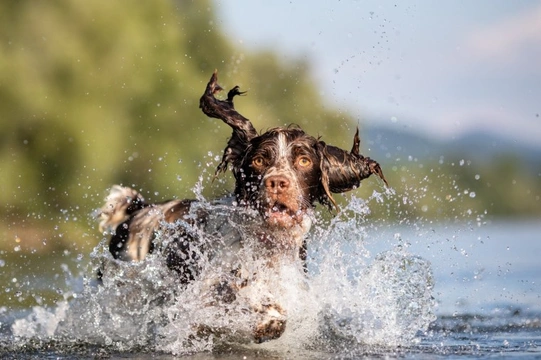
Ten water-based hazards you should consider before letting your dog swim somewhere
If you’re thinking of letting your dog swim outside somewhere, there are a lot of safety checks and considerations you need to factor in first. Even if other dogs use the area regularly or your own dog has used it before, things can change over time, so all dog owners need to be aware of how to recognise and avoid water-based hazards to dogs.
With this in mind, this article will outline ten water-based hazards to consider before you let your dog go swimming. Read on to learn more.
Blue-green algae
Blue-green algae is a seasonal hazard that can crop up in some freshwater bodies of water like lakes and ponds when conditions are right, involving a certain type of weather that initiates an algae bloom.
These algae blooms turn the water blue-green in colour, as the name suggests – and makes it toxic for dogs too. If you see water of this colour, always avoid it; and be aware that even before the colouration becomes self-evident, algae might be building up and still pose a risk to your dog.
Read more about blue-green algae and how to spot it here.
Saltwater toxicity
If you’re taking your dog swimming in the sea or otherwise swimming in saltwater, be aware of the potential threat of saltwater toxicity. This can occur if a dog swallows saltwater, either deliberately or accidentally; the former if they’re very thirsty and no fresh water is available, and the latter can occur if they get into difficulties in the water and end up swallowing a reasonable amount of it.
Always provide free access to fresh water at the beach, and read this article for more information on why you shouldn’t let your dog lap seawater.
Pool chemicals
If you have a swimming pool (lucky you!) or one of the very large inflatable paddling pools that you can get these days and set up for the whole summer, or for some families, a hot tub, the chances are you treat these with a combination of pool chemicals to keep them safe and hygienic.
If your dog drinks water with these chemicals in them this can be harmful; a couple of mouthfuls if the chemicals are in the water and diluted at the right level won’t harm your dog, but more than this might so take care.
Wildlife
A commonly overlooked water-based hazard for dogs is wildlife! Swans and geese with a nest can be very territorial, seeing your dog off and even potentially attacking them in the water. Birds like swans will out-swim dogs and have the upper hand in water, and can actually drown a dog if they attack them, so keep your dog well away from waterfowl and other wildlife, particularly around signs of nests.
Parasites
Dogs can pick up a number of water-borne parasites when swimming outside, both in and around the water. Some marshy areas might have ticks rife around the shores, and water fleas and biting bugs all come and go seasonally, so factor this in too.
Cold
Even if it’s a baking hot day and the water feels warm to your hand, it takes a long run of consistently hot days for any body of water to warm up sufficiently to be properly comfortable for a dog to swim in. Simply testing the water with your hand isn’t enough. A foot or so down, where the bulk of your dog’s body will be, it will be a lot colder, as will the water the further out they go.
Don’t be too fast to let your dog swim just because it’s a hot day or the water feels ok at first.
Heat
Heat or overly warm water isn’t something that might seem like such an issue; but as more and more families have hot tubs these days, it is something to factor in, and the same is true if you have a swimming pool as well.
A hot tub is far too hot for a dog, even if it feels comfortable or not that warm to us, and will soon cause overheating and heat stroke in dogs. Most dogs could not get out of a hot tub without help either, so always cover them when not in use and never encourage your dog to get in.
Polluted water
Polluted water doesn’t necessarily look filthy; and assuming that water is clean because it is clear is a mistake. However, if the water is obviously questionable, such as because it has oils on the surface, is a funny colour, smells funky or is otherwise gives you cause for concern, don’t let your dog get in.
Run-off of pesticides from fields can actually make water look very clean as it kills algae, and animal manure can soak into the ground and permeate into water sources too, all without making it look dangerous or dirty.
When it comes to clean-looking water, it’s not an exact science, but if you can see fish, birds on the water and signs of wildlife drinking from it, the chances are it is ok.
Underwater hazards
Be aware of the risk of hazards under the water you cannot see and that might hurt or trap your dog; anything from barbed wire to supermarket trolleys to dumped pushbikes can be found in ponds and canals when they’re drained, as well as often some far more unusual items too.
Access to get out
Finally, the last thing to check before you let your dog jump in is where they can get out. If they have to jump in at all rather than walking in, getting out may be a challenge. It is also wise to have your dog get in at the same point they will get out at, as they will instinctively head for the same place when they have had enough.



